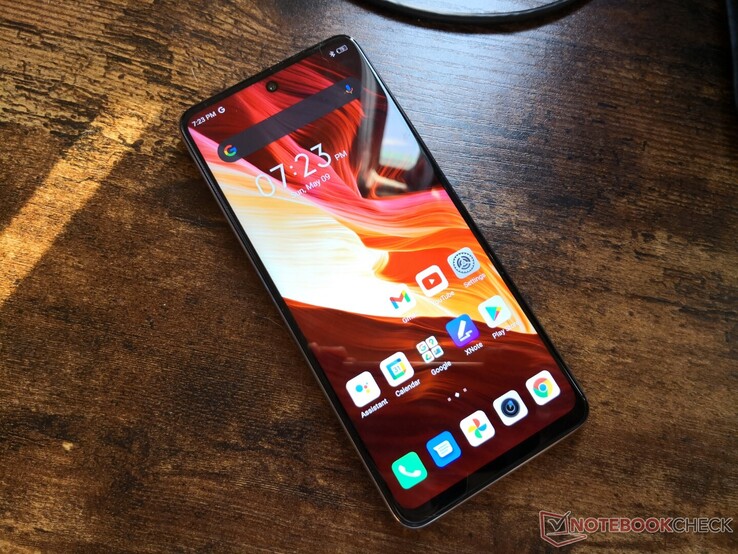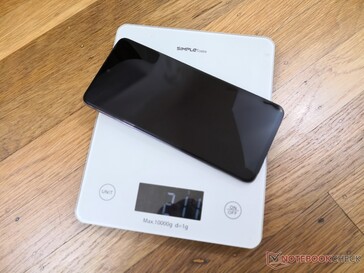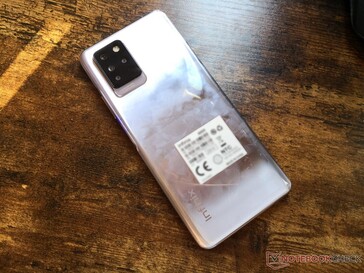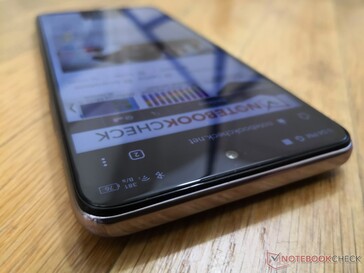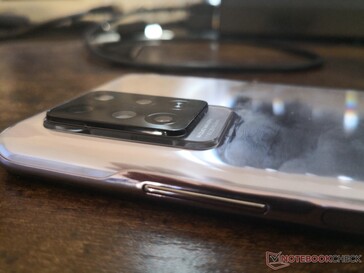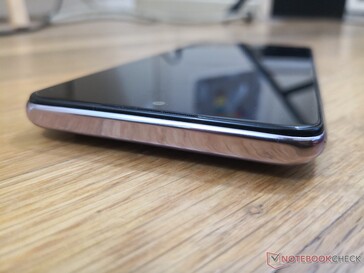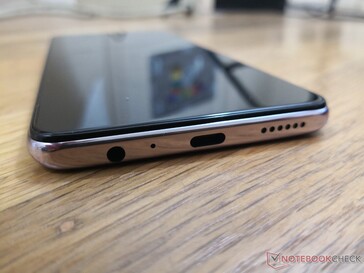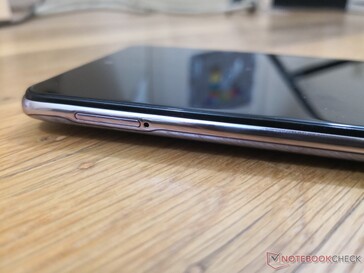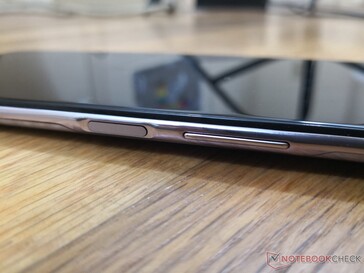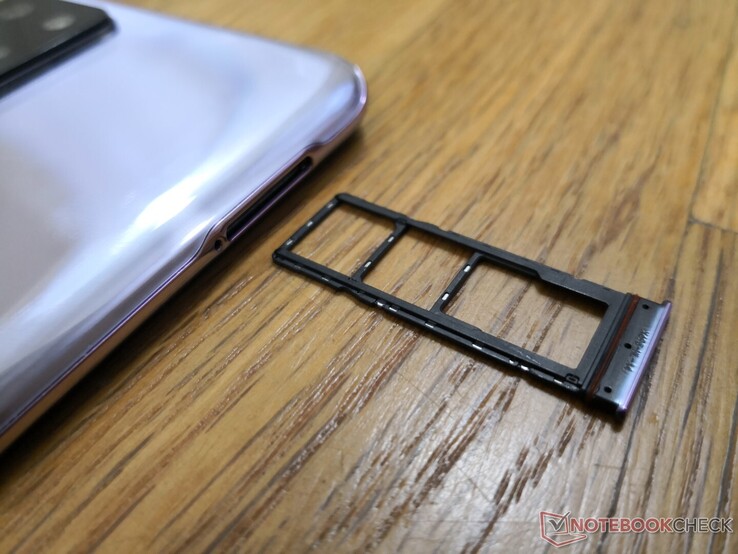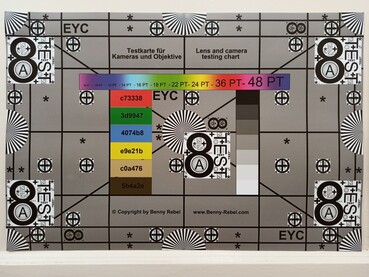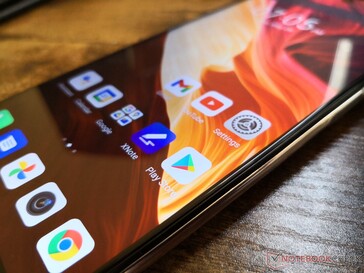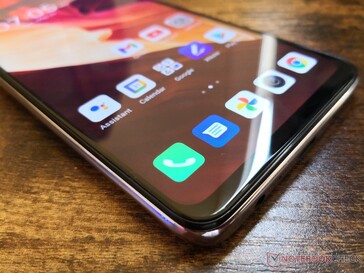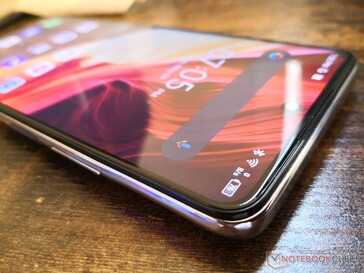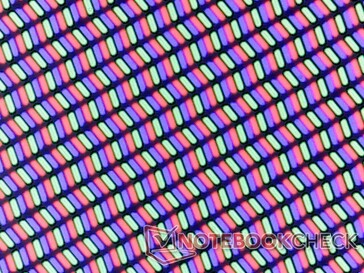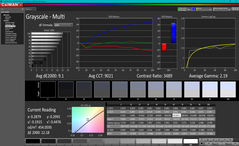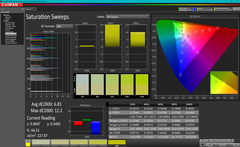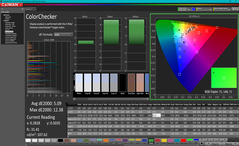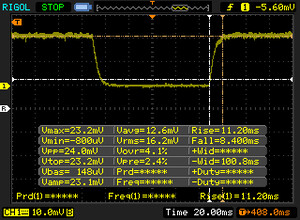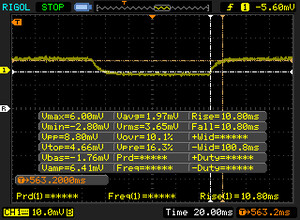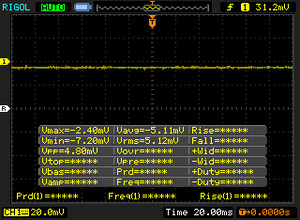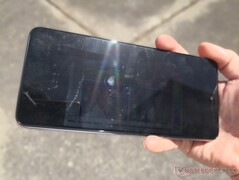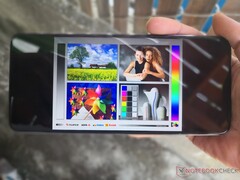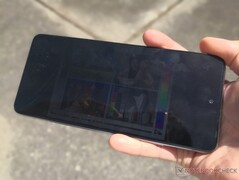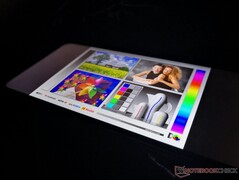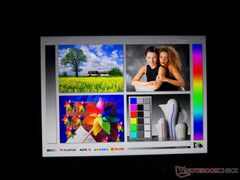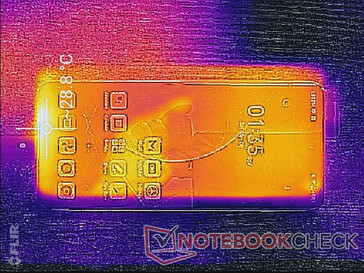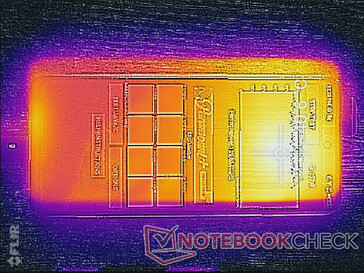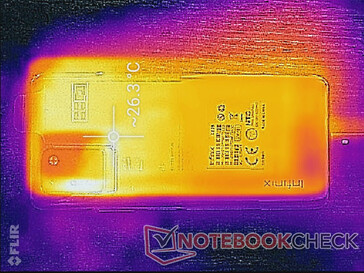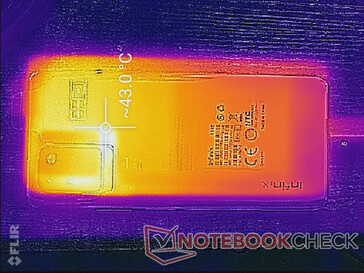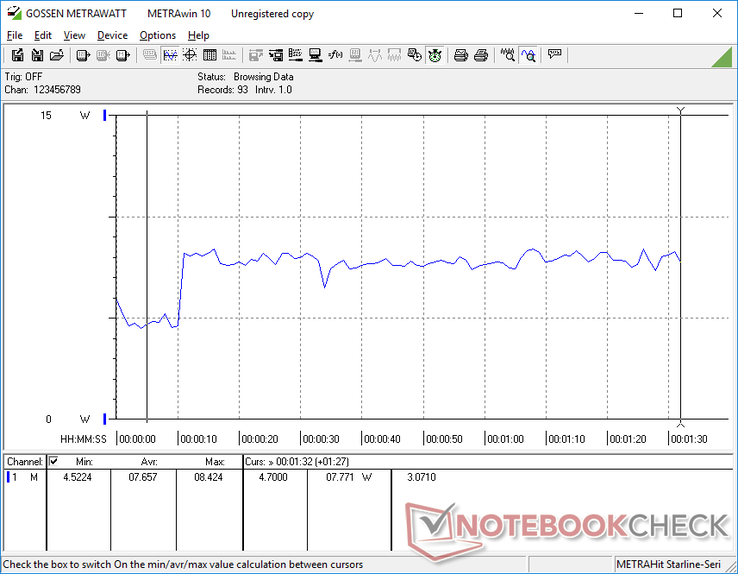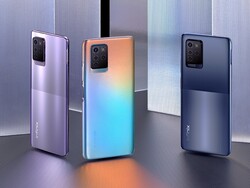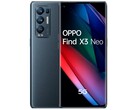Infinix Note 10 Pro Smartphone Review: Essentially a Mini Tablet

Unlike the super-cheap Hot 10S, the Infinix Note 10 Pro (not to be confused with the Samsung Galaxy Note 10) aims to bring flagship features to a mid-range price level that more users can afford. This includes a high 90 Hz refresh rate, large 6.95-inch 1080p IPS touchscreen, high 91 percent screen-to-body ratio, and support for 33 W fast charging.
Other core specifications are impressive considering the price with its MediaTek Helios G95 SoC, roomy 256 GB UFS 2.2 storage, and 8 GB of RAM. The Note 10 Pro and Note 10 Pro NFC are expected to retail for under $250 USD each.
potential competitors in comparison
Rating | Date | Model | Weight | Height | Size | Resolution | Price |
|---|---|---|---|---|---|---|---|
| 75.8 % v7 (old) | 05 / 2021 | Infinix Note 10 Pro Helio G95, Mali-G76 MP4 | 207 g | 8.77 mm | 6.95" | 1080x2460 | |
| 80.6 % v7 (old) | 05 / 2021 | Nokia X20 SD 480, Adreno 619 | 220 g | 9.1 mm | 6.67" | 2400x1080 | |
| 85.9 % v7 (old) | 05 / 2021 | Xiaomi Mi 11 Lite 5G SD 780G 5G, Adreno 642 | 159 g | 6.81 mm | 6.55" | 2400x1080 | |
| 76 % v7 (old) | 04 / 2021 | Infinix Hot 10S Helio G85, Mali-G52 MP2 | 200 g | 9.2 mm | 6.82" | 720x1640 | |
| 83 % v7 (old) | 04 / 2021 | Samsung Galaxy A52 5G SD 750G 5G, Adreno 619 | 189 g | 8.4 mm | 6.50" | 2400x1080 | |
| 71.3 % v7 (old) | 04 / 2021 | Doogee X95 Pro Helio A20 MT6761D, PowerVR GE8300 | 177 g | 8.4 mm | 6.52" | 1600x720 | |
| 87.2 % v7 (old) | 04 / 2021 | OnePlus 9 SD 888 5G, Adreno 660 | 192 g | 8.7 mm | 6.55" | 2400x1080 |
Case
The Note 10 Pro is one of the tallest smartphones we've seen beating out the OnePlus 9 or Galaxy A52 5G by quite the margin. It's also subsequently a bit heavier at around 211 g which is very close to the Samsung Galaxy Note Ultra 20. If you really value its big display, then you'll certainly have to pay for it in size.
Connectivity
Ports include USB-C and the all-important 3.5 mm audio jack. Though USB OTG is supported for keyboard, mice, and external drives, attempting to connect external monitors will not work unlike on most Huawei Mate and Samsung Galaxy smartphones.
Communication
WLAN transfer rates are similar to what we recorded on the Hot 10S. 4G LTE is thankfully supported on most GSM networks in the U.S. which is more than what we can say for many other Chinese smartphones.
Webcam
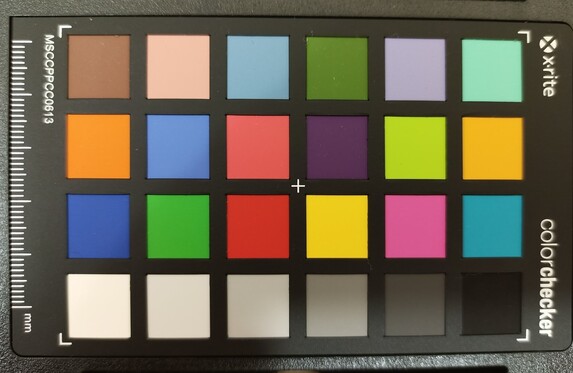
Accessories and Warranty
The retail packaging includes a screen protector, USB-A to USB-C cable, and AC power adapter. Warranty may be difficult to claim in North America as the device is not officially available in this region.
Display
The most distinguishing feature of the Note 10 Pro is its nearly 7-inch display. It even manages to carry a native 1080p resolution and 90 Hz refresh rate unlike the 720p display of most other inexpensive smartphones. PPI is identical to the competing Samsung Galaxy A52 5G and response times are also better than expected considering the low asking price.
The two biggest drawbacks of the display are its color inaccuracies and limited maximum brightness. Infinix advertises a maximum brightness of 480 nits, but the average is only about 423 nits since the sides of the screen are slightly dimmer than its center. The Nokia X20 is almost 50 percent brighter and the aforementioned Samsung is even brighter still for better outdoor visibility.
| |||||||||||||||||||||||||
Brightness Distribution: 88 %
Center on Battery: 452.5 cd/m²
Contrast: 2155:1 (Black: 0.21 cd/m²)
ΔE ColorChecker Calman: 5.09 | ∀{0.5-29.43 Ø4.78}
ΔE Greyscale Calman: 9.1 | ∀{0.09-98 Ø5}
Gamma: 2.19
CCT: 9021 K
| Infinix Note 10 Pro 7", 1080x2460 | Nokia X20 IPS, 6.7", 2400x1080 | Xiaomi Mi 11 Lite 5G AMOLED, 6.6", 2400x1080 | Infinix Hot 10S 6.8", 720x1640 | Samsung Galaxy A52 5G Super AMOLED, 6.5", 2400x1080 | Doogee X95 Pro IPS, 6.5", 1600x720 | OnePlus 9 AMOLED, 6.6", 2400x1080 | |
|---|---|---|---|---|---|---|---|
| Response Times | -46% | 83% | -91% | 87% | -150% | 38% | |
| Response Time Grey 50% / Grey 80% * (ms) | 21.6 ? | 43 ? -99% | 4 ? 81% | 45.6 ? -111% | 3.2 ? 85% | 63.2 ? -193% | 20 ? 7% |
| Response Time Black / White * (ms) | 19.6 ? | 18 ? 8% | 3.2 ? 84% | 33.6 ? -71% | 2.4 ? 88% | 40.4 ? -106% | 6 ? 69% |
| PWM Frequency (Hz) | 367.6 ? | 250 ? | 323.6 | ||||
| Screen | -19% | 59% | 14% | 55% | 11% | 69% | |
| Brightness middle (cd/m²) | 452.5 | 646 43% | 863 91% | 459.8 2% | 744 64% | 382.2 -16% | 731 62% |
| Brightness (cd/m²) | 423 | 617 46% | 860 103% | 456 8% | 749 77% | 357 -16% | 739 75% |
| Brightness Distribution (%) | 88 | 89 1% | 93 6% | 95 8% | 98 11% | 86 -2% | 96 9% |
| Black Level * (cd/m²) | 0.21 | 0.7 -233% | 0.17 19% | 0.18 14% | |||
| Contrast (:1) | 2155 | 923 -57% | 2705 26% | 2123 -1% | |||
| Colorchecker dE 2000 * | 5.09 | 5.71 -12% | 3.2 37% | 5.36 -5% | 2.2 57% | 4.4 14% | 0.59 88% |
| Colorchecker dE 2000 max. * | 12.38 | 8.9 28% | 5.2 58% | 9.78 21% | 7 43% | 8.12 34% | 1.3 89% |
| Greyscale dE 2000 * | 9.1 | 6.2 32% | 3.9 57% | 5.8 36% | 2.1 77% | 3.4 63% | 0.9 90% |
| Gamma | 2.19 100% | 2.122 104% | 2.33 94% | 2.14 103% | 2.06 107% | 2.03 108% | 2.243 98% |
| CCT | 9021 72% | 8256 79% | 7299 89% | 7980 81% | 6516 100% | 6963 93% | 6573 99% |
| Total Average (Program / Settings) | -33% /
-24% | 71% /
65% | -39% /
-7% | 71% /
63% | -70% /
-21% | 54% /
61% |
* ... smaller is better
Display Response Times
| ↔ Response Time Black to White | ||
|---|---|---|
| 19.6 ms ... rise ↗ and fall ↘ combined | ↗ 11.2 ms rise | |
| ↘ 8.4 ms fall | ||
| The screen shows good response rates in our tests, but may be too slow for competitive gamers. In comparison, all tested devices range from 0.1 (minimum) to 240 (maximum) ms. » 42 % of all devices are better. This means that the measured response time is similar to the average of all tested devices (20.2 ms). | ||
| ↔ Response Time 50% Grey to 80% Grey | ||
| 21.6 ms ... rise ↗ and fall ↘ combined | ↗ 10.8 ms rise | |
| ↘ 10.8 ms fall | ||
| The screen shows good response rates in our tests, but may be too slow for competitive gamers. In comparison, all tested devices range from 0.165 (minimum) to 636 (maximum) ms. » 32 % of all devices are better. This means that the measured response time is better than the average of all tested devices (31.6 ms). | ||
Screen Flickering / PWM (Pulse-Width Modulation)
| Screen flickering / PWM not detected | |||
In comparison: 53 % of all tested devices do not use PWM to dim the display. If PWM was detected, an average of 8108 (minimum: 5 - maximum: 343500) Hz was measured. | |||
Performance
When compared to the MediaTek Helio G85 in the Hot 10S, the Helios G95 is significantly faster. Most CPU-heavy and GPU-heavy benchmarks show the G95 to be well ahead by quite the margin. Overall performance is most comparable to the mid-range Qualcomm Snapdragon 750G.
A demanding game like Genshin Impact will run choppily on the default Medium settings when battling enemies in the open world. Lowering the settings will reduce the stuttering while improving frame rates to the 30 to 40 FPS range.
PCMark for Android: Work 2.0 performance score
GFXBench: on screen Aztec Ruins High Tier Onscreen | 2560x1440 Aztec Ruins High Tier Offscreen | on screen Aztec Ruins Normal Tier Onscreen | 1920x1080 Aztec Ruins Normal Tier Offscreen
3DMark: 2560x1440 Sling Shot Extreme (ES 3.1) Unlimited | 2560x1440 Sling Shot Extreme (ES 3.1) Unlimited Graphics | 2560x1440 Sling Shot Extreme (ES 3.1) Unlimited Physics
WebXPRT 3: Overall
| Geekbench 5.5 / OpenCL Score | |
| OnePlus 9 | |
| Oppo Find X3 Neo | |
| Infinix Note 10 Pro | |
| Samsung Galaxy A52 5G | |
| Realme 8 Pro | |
| Infinix Hot 10S | |
| Motorola Moto G30 | |
| Motorola Moto G10 | |
| PCMark for Android / Work 2.0 performance score | |
| Oppo Find X3 Neo | |
| Realme 6 | |
| OnePlus 9 | |
| Infinix Note 10 Pro | |
| Samsung Galaxy A52 5G | |
| Infinix Hot 10S | |
| Realme 8 Pro | |
| Motorola Moto G30 | |
| Nokia 2.4 | |
| Motorola Moto G10 | |
| GFXBench / Aztec Ruins High Tier Onscreen | |
| OnePlus 9 | |
| Apple iPhone 12 Pro Max | |
| Oppo Find X3 Neo | |
| Infinix Hot 10S | |
| Realme 6 | |
| Realme 8 Pro | |
| Samsung Galaxy A52 5G | |
| Infinix Note 10 Pro | |
| Motorola Moto G30 | |
| Motorola Moto G10 | |
| Nokia 2.4 | |
| GFXBench / Aztec Ruins High Tier Offscreen | |
| Apple iPhone 12 Pro Max | |
| OnePlus 9 | |
| Oppo Find X3 Neo | |
| Infinix Note 10 Pro | |
| Samsung Galaxy A52 5G | |
| Realme 8 Pro | |
| Realme 6 | |
| Infinix Hot 10S | |
| Motorola Moto G30 | |
| Motorola Moto G10 | |
| Nokia 2.4 | |
| GFXBench / Aztec Ruins Normal Tier Onscreen | |
| OnePlus 9 | |
| Oppo Find X3 Neo | |
| Apple iPhone 12 Pro Max | |
| Realme 6 | |
| Samsung Galaxy A52 5G | |
| Infinix Note 10 Pro | |
| Realme 8 Pro | |
| Motorola Moto G30 | |
| Infinix Hot 10S | |
| Motorola Moto G10 | |
| Nokia 2.4 | |
| GFXBench / Aztec Ruins Normal Tier Offscreen | |
| Apple iPhone 12 Pro Max | |
| Oppo Find X3 Neo | |
| OnePlus 9 | |
| Infinix Note 10 Pro | |
| Realme 6 | |
| Samsung Galaxy A52 5G | |
| Realme 8 Pro | |
| Motorola Moto G30 | |
| Infinix Hot 10S | |
| Motorola Moto G10 | |
| Nokia 2.4 | |
| 3DMark / Sling Shot Extreme (ES 3.1) Unlimited | |
| Oppo Find X3 Neo | |
| Apple iPhone 12 Pro Max | |
| Samsung Galaxy A52 5G | |
| Infinix Note 10 Pro | |
| Realme 8 Pro | |
| Realme 6 | |
| Infinix Hot 10S | |
| Motorola Moto G30 | |
| Motorola Moto G10 | |
| Nokia 2.4 | |
| Doogee X95 Pro | |
| OnePlus 9 | |
| 3DMark / Sling Shot Extreme (ES 3.1) Unlimited Graphics | |
| Oppo Find X3 Neo | |
| Apple iPhone 12 Pro Max | |
| Samsung Galaxy A52 5G | |
| Infinix Note 10 Pro | |
| Realme 8 Pro | |
| Realme 6 | |
| Infinix Hot 10S | |
| Motorola Moto G30 | |
| Motorola Moto G10 | |
| Nokia 2.4 | |
| Doogee X95 Pro | |
| 3DMark / Sling Shot Extreme (ES 3.1) Unlimited Physics | |
| Oppo Find X3 Neo | |
| Samsung Galaxy A52 5G | |
| Infinix Note 10 Pro | |
| Realme 6 | |
| Realme 8 Pro | |
| Apple iPhone 12 Pro Max | |
| Infinix Hot 10S | |
| Motorola Moto G30 | |
| Motorola Moto G10 | |
| Nokia 2.4 | |
| Doogee X95 Pro | |
| WebXPRT 3 / Overall | |
| Apple iPhone 12 Pro Max | |
| OnePlus 9 | |
| Oppo Find X3 Neo | |
| Samsung Galaxy A52 5G | |
| Motorola Moto G30 | |
| Infinix Note 10 Pro | |
| Realme 6 | |
| Infinix Hot 10S | |
| Motorola Moto G10 | |
| Doogee X95 Pro | |
PCMark for Android: Work 2.0 performance score
GFXBench: on screen Aztec Ruins High Tier Onscreen | 2560x1440 Aztec Ruins High Tier Offscreen | on screen Aztec Ruins Normal Tier Onscreen | 1920x1080 Aztec Ruins Normal Tier Offscreen
3DMark: 2560x1440 Sling Shot Extreme (ES 3.1) Unlimited | 2560x1440 Sling Shot Extreme (ES 3.1) Unlimited Graphics | 2560x1440 Sling Shot Extreme (ES 3.1) Unlimited Physics
WebXPRT 3: Overall
Storage Devices
Not only is storage capacity two times larger than on the Hot 10S, but sequential transfer rates are also two times faster. Smartphones with UHS 3.1, such as the OnePlus 9, can have transfer rates 2x to 4x faster than our Note 10 Pro.
MicroSD cards are supported, but we experienced the same issues as on the Hot 10S where write rates would be abnormally slow in the single digits range even after testing different UHS-I and UHS-II MicroSD cards. We're not sure why this is happening, but we highly recommend testing out the MicroSD reader immediately after purchasing for any abnormalities.
| Infinix Note 10 Pro 256 GB UFS 2.2 Flash | Samsung Galaxy A52 5G 128 GB UFS 2.1 Flash | Doogee X95 Pro 32 GB eMMC Flash | Realme 8 Pro 128 GB UFS 2.1 Flash | OnePlus 9 256 GB UFS 3.1 Flash | Infinix Hot 10S 128 GB eMMC Flash | |
|---|---|---|---|---|---|---|
| AndroBench 3-5 | 26% | -73% | -39% | 102% | -50% | |
| Sequential Write 256KB SDCard (MB/s) | 61.3 | 35.3 | ||||
| Sequential Read 256KB SDCard (MB/s) | 83.3 | 62.7 | ||||
| Random Write 4KB (MB/s) | 175.1 | 179.2 2% | 10.95 -94% | 84.8 -52% | 221.4 26% | 68.2 -61% |
| Random Read 4KB (MB/s) | 193.4 | 176.1 -9% | 32.59 -83% | 98.5 -49% | 225.4 17% | 108 -44% |
| Sequential Write 256KB (MB/s) | 369.4 | 484.6 31% | 118.6 -68% | 191.7 -48% | 739 100% | 175.4 -53% |
| Sequential Read 256KB (MB/s) | 514 | 927 80% | 277 -46% | 474 -8% | 1872 264% | 307.8 -40% |
Emissions
Temperature
Surface temperatures can be as warm as 41 C to 43 C when running demanding loads like games. These hot spots are small and concentrated, however, meaning most of the smartphone is still relatively cool and comfortable to handle. In comparison, the OnePlus 9 will be much warmer on average when under similar conditions.
(±) The maximum temperature on the upper side is 40.8 °C / 105 F, compared to the average of 35.2 °C / 95 F, ranging from 21.9 to 247 °C for the class Smartphone.
(±) The bottom heats up to a maximum of 44 °C / 111 F, compared to the average of 34 °C / 93 F
(+) In idle usage, the average temperature for the upper side is 25.5 °C / 78 F, compared to the device average of 32.9 °C / 91 F.
Speakers
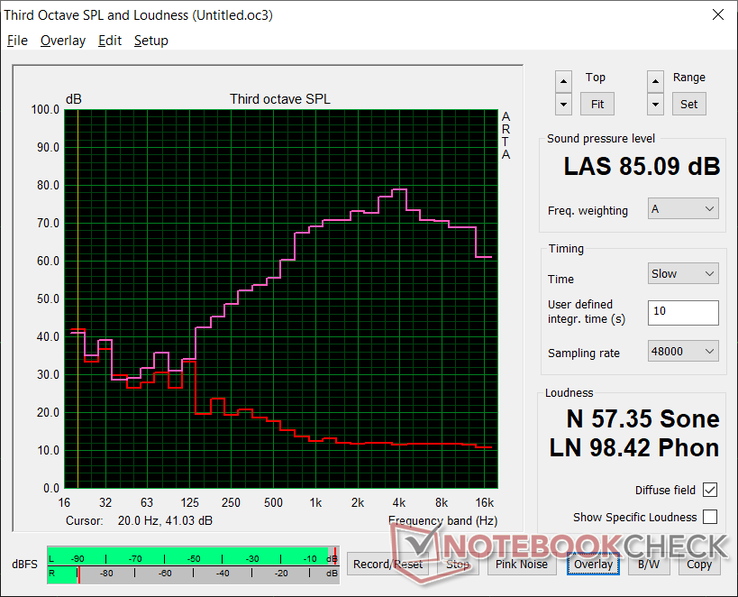
Infinix Note 10 Pro audio analysis
(+) | speakers can play relatively loud (85.1 dB)
Bass 100 - 315 Hz
(-) | nearly no bass - on average 26.6% lower than median
(±) | linearity of bass is average (7.7% delta to prev. frequency)
Mids 400 - 2000 Hz
(±) | reduced mids - on average 5.9% lower than median
(+) | mids are linear (4.6% delta to prev. frequency)
Highs 2 - 16 kHz
(+) | balanced highs - only 4.2% away from median
(+) | highs are linear (4.2% delta to prev. frequency)
Overall 100 - 16.000 Hz
(±) | linearity of overall sound is average (19.3% difference to median)
Compared to same class
» 26% of all tested devices in this class were better, 9% similar, 65% worse
» The best had a delta of 11%, average was 35%, worst was 134%
Compared to all devices tested
» 46% of all tested devices were better, 8% similar, 47% worse
» The best had a delta of 4%, average was 24%, worst was 134%
Apple MacBook 12 (Early 2016) 1.1 GHz audio analysis
(+) | speakers can play relatively loud (83.6 dB)
Bass 100 - 315 Hz
(±) | reduced bass - on average 11.3% lower than median
(±) | linearity of bass is average (14.2% delta to prev. frequency)
Mids 400 - 2000 Hz
(+) | balanced mids - only 2.4% away from median
(+) | mids are linear (5.5% delta to prev. frequency)
Highs 2 - 16 kHz
(+) | balanced highs - only 2% away from median
(+) | highs are linear (4.5% delta to prev. frequency)
Overall 100 - 16.000 Hz
(+) | overall sound is linear (10.2% difference to median)
Compared to same class
» 7% of all tested devices in this class were better, 2% similar, 91% worse
» The best had a delta of 5%, average was 18%, worst was 53%
Compared to all devices tested
» 4% of all tested devices were better, 1% similar, 94% worse
» The best had a delta of 4%, average was 24%, worst was 134%
Energy Management
Power Consumption
| Off / Standby | |
| Idle | |
| Load |
|
Key:
min: | |
| Infinix Note 10 Pro Helio G95, Mali-G76 MP4, 256 GB UFS 2.2 Flash, , 1080x2460, 7" | Xiaomi Mi 11 Lite 5G SD 780G 5G, Adreno 642, 128 GB UFS 2.2 Flash, AMOLED, 2400x1080, 6.6" | Infinix Hot 10S Helio G85, Mali-G52 MP2, 128 GB eMMC Flash, , 720x1640, 6.8" | Samsung Galaxy A52 5G SD 750G 5G, Adreno 619, 128 GB UFS 2.1 Flash, Super AMOLED, 2400x1080, 6.5" | Doogee X95 Pro Helio A20 MT6761D, PowerVR GE8300, 32 GB eMMC Flash, IPS, 1600x720, 6.5" | OnePlus 9 SD 888 5G, Adreno 660, 256 GB UFS 3.1 Flash, AMOLED, 2400x1080, 6.6" | |
|---|---|---|---|---|---|---|
| Power Consumption | 36% | 16% | 43% | 46% | 21% | |
| Idle Minimum * (Watt) | 2.5 | 0.83 67% | 1.7 32% | 0.92 63% | 0.5 80% | 0.9 64% |
| Idle Average * (Watt) | 3.6 | 1.92 47% | 2.9 19% | 1.78 51% | 2 44% | 1.7 53% |
| Idle Maximum * (Watt) | 3.7 | 1.97 47% | 3 19% | 1.81 51% | 2.7 27% | 2.7 27% |
| Load Average * (Watt) | 5 | 3.84 23% | 5.3 -6% | 3.86 23% | 3.7 26% | 5.4 -8% |
| Load Maximum * (Watt) | 8.4 | 8.6 -2% | 7 17% | 6.14 27% | 3.8 55% | 11.1 -32% |
* ... smaller is better
Battery Life
We're able to record a real-world WLAN runtime of 15.5 hours from the fully charged 5000 mAh battery. Charging from 0 to 81 percent capacity takes just 60 minutes with the included 33 W AC adapter.
| Infinix Note 10 Pro Helio G95, Mali-G76 MP4, Wh | Nokia X20 SD 480, Adreno 619, Wh | Xiaomi Mi 11 Lite 5G SD 780G 5G, Adreno 642, Wh | Infinix Hot 10S Helio G85, Mali-G52 MP2, Wh | Samsung Galaxy A52 5G SD 750G 5G, Adreno 619, Wh | Doogee X95 Pro Helio A20 MT6761D, PowerVR GE8300, Wh | OnePlus 9 SD 888 5G, Adreno 660, Wh | |
|---|---|---|---|---|---|---|---|
| Battery runtime | -5% | -21% | 32% | -24% | -5% | -8% | |
| WiFi v1.3 (h) | 15.5 | 14.7 -5% | 12.2 -21% | 20.5 32% | 11.8 -24% | 14.7 -5% | 14.2 -8% |
| Reader / Idle (h) | 25.2 | 32 | 27.1 | ||||
| Load (h) | 3.7 | 5.4 | 2.8 |
Pros
Cons
Verdict
The Infinix Note 10 Pro is a great example of higher-end features trickling down to lower-end models. You previously had to pay hundreds of dollars more for a 90 Hz 1080p display with 180 Hz touch sampling rate, fast response times, IR scanner, 64 MP camera, 256 GB of storage, 8 GB of RAM, and a processor that's actually decent. We suspect that future models will start to incorporate even more auxiliary features like an onscreen fingerprint reader, wireless charger, or 5G connectivity.
The Infinix Note 10 Pro has one of the largest touchscreens and smoothest UI experience for the price. The average color accuracy and brightness should be tolerable for most budget users, but the heavy bloatware leaves a sour taste in our mouth.
As with any other inexpensive smartphone, however, there are some hidden cut corners. Most notably, the display is dimmer than most mid-range to higher-end smartphones and colors are not nearly as accurate. QA is also questionable as this is the second time on an Infinix smartphone where we experienced MicroSD write issues. Otherwise, there's a lot to like here especially if you're attracted to larger displays.
Price and availability
The Infinix Note 10 Pro is not yet widely available in North America. The manufacturer is aiming for markets in South Asia, Southeast Asia, Africa, and Latin America instead.
Infinix Note 10 Pro
- 05/30/2021 v7 (old)
Allen Ngo




